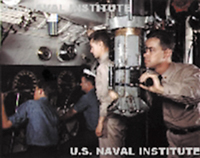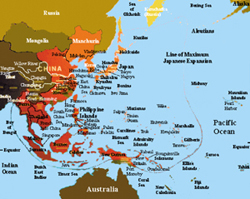|
 When
Japan bombed Pearl Harbor, Richard Jenke was only fourteen years old, but
he was more than ready to play his part in the conflict. “This was the biggest
shock our nation had had in a long time,” remembers his wife, Irma. Richard
clearly recalls the day after the bombing. “[It was] the first time I skipped
school in my entire life . . . to try and join the Marines,” he laughs. “Guys
were there by the hundreds to enlist, and there I was, fourteen years old.
The guy said, ‘Son, you go on home and grow up and come back to see us.’”
Determined to serve his country, Richard contrived a story to fool the Navy
recruiters into thinking he was old enough to enlist. To his surprise, the
recruiters believed his tall tale, and by 1942, Richard was serving aboard
a Navy submarine in the Pacific. When
Japan bombed Pearl Harbor, Richard Jenke was only fourteen years old, but
he was more than ready to play his part in the conflict. “This was the biggest
shock our nation had had in a long time,” remembers his wife, Irma. Richard
clearly recalls the day after the bombing. “[It was] the first time I skipped
school in my entire life . . . to try and join the Marines,” he laughs. “Guys
were there by the hundreds to enlist, and there I was, fourteen years old.
The guy said, ‘Son, you go on home and grow up and come back to see us.’”
Determined to serve his country, Richard contrived a story to fool the Navy
recruiters into thinking he was old enough to enlist. To his surprise, the
recruiters believed his tall tale, and by 1942, Richard was serving aboard
a Navy submarine in the Pacific.
Richard
had a very important role aboard the diesel-powered submarine. “I served as
the  electrician,”
he explains. “It was a tough way to go because . . . you had to take a test
over that theory and . . . your job.” Richard continues, “My job was to take
care of the batteries, take care of the generators, motors, and anything else
electrical.” He had to clean off the carbon that would build up on the motors
and generators so they would run smoothly. Two hundred and fifty-two battery
cells weighing more than 1500 pounds were also under Richard’s care. “When
I wasn’t doing that, I was on propulsion,” he adds. This meant that Richard
had to monitor the transfer of power from the generators to the motors, an
extremely important job. The electricity Richard helped generate kept the
submarine cruising through the Pacific at about ten miles per hour. “Modern
day submarines are very fast. Much faster than that,” he chuckles. electrician,”
he explains. “It was a tough way to go because . . . you had to take a test
over that theory and . . . your job.” Richard continues, “My job was to take
care of the batteries, take care of the generators, motors, and anything else
electrical.” He had to clean off the carbon that would build up on the motors
and generators so they would run smoothly. Two hundred and fifty-two battery
cells weighing more than 1500 pounds were also under Richard’s care. “When
I wasn’t doing that, I was on propulsion,” he adds. This meant that Richard
had to monitor the transfer of power from the generators to the motors, an
extremely important job. The electricity Richard helped generate kept the
submarine cruising through the Pacific at about ten miles per hour. “Modern
day submarines are very fast. Much faster than that,” he chuckles.
 Richard
traveled all over the Pacific as his submarine made regular patrols of the
ocean. He was carried from Australia to Indonesia, New Guinea, the Solomon
Islands, and even north to Korea. “We covered quite a bit of the Pacific.”
Along the way, “there were many missions . . . done by the submarine force.”
Richard recalls, “The submarine’s mission [was not only] to seek and destroy
the Japanese merchant marine and navy . . . but also to supply the guerillas
in the Philippines.” The crew was involved in rescue missions as well. Nonetheless,
defeating Japan was at the heart of all of the submarine’s missions. “We went
after them wherever they went,” Richard says. Richard
traveled all over the Pacific as his submarine made regular patrols of the
ocean. He was carried from Australia to Indonesia, New Guinea, the Solomon
Islands, and even north to Korea. “We covered quite a bit of the Pacific.”
Along the way, “there were many missions . . . done by the submarine force.”
Richard recalls, “The submarine’s mission [was not only] to seek and destroy
the Japanese merchant marine and navy . . . but also to supply the guerillas
in the Philippines.” The crew was involved in rescue missions as well. Nonetheless,
defeating Japan was at the heart of all of the submarine’s missions. “We went
after them wherever they went,” Richard says.
Richard
spent thirty-four months in the Pacific defending the U.S. against its enemies,
and was overjoyed to return home. “There [were] times when many of us never
thought we’d see this country again,” he says. “I learned from my experience
. . . to appreciate the things we [have] and to appreciate this country.”
Richard says he would serve again if he was needed, but also recognizes the
contribution people on the homefront made to the effort. His wife, Irma, worked
in a weapons and ammunition factory while Richard was away. He declares, “We
wouldn’t have won that war without people like my wife. They did it for us.
|


 When
Japan bombed Pearl Harbor, Richard Jenke was only fourteen years old, but
he was more than ready to play his part in the conflict. “This was the biggest
shock our nation had had in a long time,” remembers his wife, Irma. Richard
clearly recalls the day after the bombing. “[It was] the first time I skipped
school in my entire life . . . to try and join the Marines,” he laughs. “Guys
were there by the hundreds to enlist, and there I was, fourteen years old.
The guy said, ‘Son, you go on home and grow up and come back to see us.’”
Determined to serve his country, Richard contrived a story to fool the Navy
recruiters into thinking he was old enough to enlist. To his surprise, the
recruiters believed his tall tale, and by 1942, Richard was serving aboard
a Navy submarine in the Pacific.
When
Japan bombed Pearl Harbor, Richard Jenke was only fourteen years old, but
he was more than ready to play his part in the conflict. “This was the biggest
shock our nation had had in a long time,” remembers his wife, Irma. Richard
clearly recalls the day after the bombing. “[It was] the first time I skipped
school in my entire life . . . to try and join the Marines,” he laughs. “Guys
were there by the hundreds to enlist, and there I was, fourteen years old.
The guy said, ‘Son, you go on home and grow up and come back to see us.’”
Determined to serve his country, Richard contrived a story to fool the Navy
recruiters into thinking he was old enough to enlist. To his surprise, the
recruiters believed his tall tale, and by 1942, Richard was serving aboard
a Navy submarine in the Pacific. electrician,”
he explains. “It was a tough way to go because . . . you had to take a test
over that theory and . . . your job.” Richard continues, “My job was to take
care of the batteries, take care of the generators, motors, and anything else
electrical.” He had to clean off the carbon that would build up on the motors
and generators so they would run smoothly. Two hundred and fifty-two battery
cells weighing more than 1500 pounds were also under Richard’s care. “When
I wasn’t doing that, I was on propulsion,” he adds. This meant that Richard
had to monitor the transfer of power from the generators to the motors, an
extremely important job. The electricity Richard helped generate kept the
submarine cruising through the Pacific at about ten miles per hour. “Modern
day submarines are very fast. Much faster than that,” he chuckles.
electrician,”
he explains. “It was a tough way to go because . . . you had to take a test
over that theory and . . . your job.” Richard continues, “My job was to take
care of the batteries, take care of the generators, motors, and anything else
electrical.” He had to clean off the carbon that would build up on the motors
and generators so they would run smoothly. Two hundred and fifty-two battery
cells weighing more than 1500 pounds were also under Richard’s care. “When
I wasn’t doing that, I was on propulsion,” he adds. This meant that Richard
had to monitor the transfer of power from the generators to the motors, an
extremely important job. The electricity Richard helped generate kept the
submarine cruising through the Pacific at about ten miles per hour. “Modern
day submarines are very fast. Much faster than that,” he chuckles. Richard
traveled all over the Pacific as his submarine made regular patrols of the
ocean. He was carried from Australia to Indonesia, New Guinea, the Solomon
Islands, and even north to Korea. “We covered quite a bit of the Pacific.”
Along the way, “there were many missions . . . done by the submarine force.”
Richard recalls, “The submarine’s mission [was not only] to seek and destroy
the Japanese merchant marine and navy . . . but also to supply the guerillas
in the Philippines.” The crew was involved in rescue missions as well. Nonetheless,
defeating Japan was at the heart of all of the submarine’s missions. “We went
after them wherever they went,” Richard says.
Richard
traveled all over the Pacific as his submarine made regular patrols of the
ocean. He was carried from Australia to Indonesia, New Guinea, the Solomon
Islands, and even north to Korea. “We covered quite a bit of the Pacific.”
Along the way, “there were many missions . . . done by the submarine force.”
Richard recalls, “The submarine’s mission [was not only] to seek and destroy
the Japanese merchant marine and navy . . . but also to supply the guerillas
in the Philippines.” The crew was involved in rescue missions as well. Nonetheless,
defeating Japan was at the heart of all of the submarine’s missions. “We went
after them wherever they went,” Richard says.